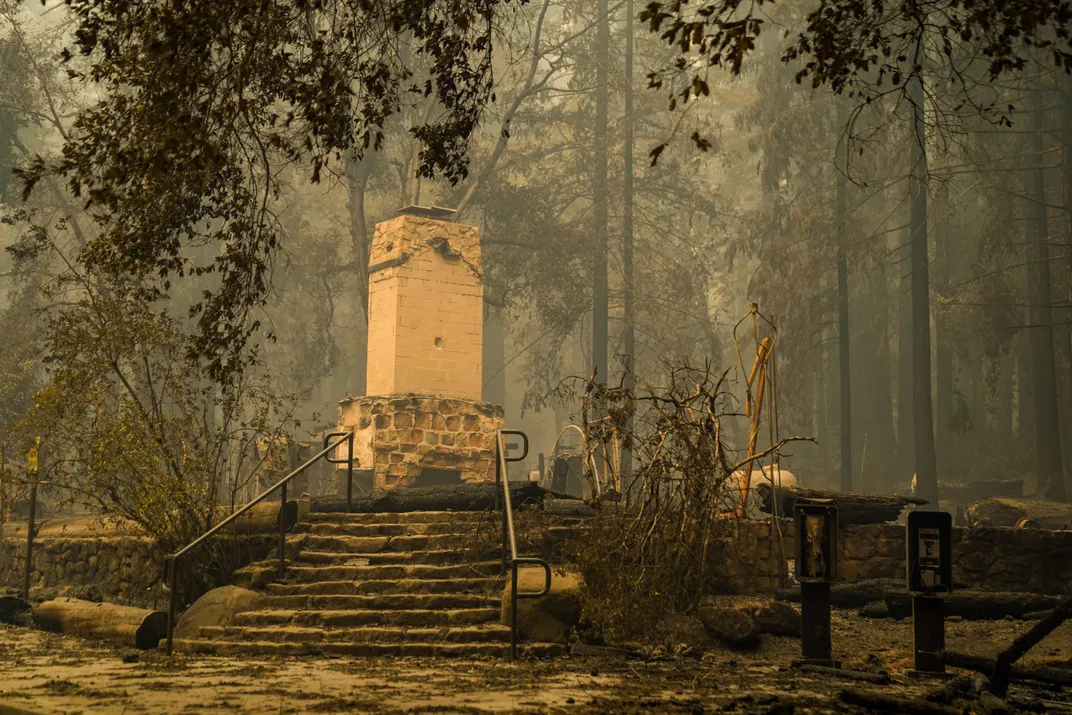Wildfire Burns California’s Oldest State Park—but Most Redwoods Should Recover Soon
However, the park lost its historic core infrastructure, including headquarters, amphitheater and campgrounds
/https://tf-cmsv2-smithsonianmag-media.s3.amazonaws.com/filer/54/99/5499bcbc-087c-4235-a12e-2da59cdf49d2/2020_aug24_bigbasin.jpg)
More than one million acres have burned in California’s wildfires. The third largest, the CZU Lightning Complex, has been burning since Monday, August 17 in Santa Cruz County.
By Thursday, the fire complex had burned through much of Big Basin State Park and some fires continue to smolder in the park, Ethan Baron and Randy Vazquez report for the Mercury News. Established in 1902, Big Basin is California’s oldest state park.
Its iconic redwood trees and wildlife are adapted to withstand fire, but the human-built structures were not. The park’s “historic core,” including its headquarters, campgrounds and amphitheater built in the 1930s were lost in the blaze, Shawn Hubler and Kellen Browning report for the New York Times.
“A piece of history may have been lost with the destruction of those classic facilities at Big Basin, but redwood forests are resilient and the people of California are resilient,” Sara Barth, executive director of the redwood conservation group Sempervirens Fund, tells the Santa Cruz Sentinel’s Paul Rogers and Ethan Baron. “I’m confident Big Basin will be reborn from the ashes.”

Redwood trees evolved to withstand regular wildfires. Some of the oldest have trunks over 20 feet wide and can grow over 350 feet tall. Large redwoods can have bark that’s one foot thick, which acts as a barrier that prevents fire from reaching the vital nutrient-carrying wood underneath. And while some trees are doomed if a fire scorches their crowns, redwoods have buds beneath their bark that sprout new foliage after a fire.
In some trees, fire burned through their bark and ate away at the base of the trunk. When enough of a tree’s base burns, it can no longer hold up the weight of its skyscraper-tall trunk, and the tree falls. The Mercury News reported that a tree with a trunk more than 12 feet wide fell near the park’s headquarters. But the vast majority of trees seem to have survived the blaze.
“None of this looks that bad to me,” research forester Mark Finney told the Mercury News’ Paul Rogers after seeing photographs of Big Basin’s trees after the fire. “There’s a lot of scorch in there, but most of these trees are fine. You can see brown foliage on these trees. It doesn’t mean the tree is dead at all... Most of these trees will do just fine.”
Older trees, with trunks more than 1.5 feet thick, have the best chance of surviving the blaze based on previous fires, per the Mercury News. Younger trees with thinner trunks don’t have the as thick bark to protect them, and because they grow closer together, fires can burn hotter and spread more quickly, Lauren Sommer reports for NPR.
The younger trees are part of the redwoods’ second-growth forest that have sprouted in the last two centuries. Old coastal redwoods are over 1,000 years old, and the giant trees once covered a much larger swath of the west coast. Native American tribes managed the land at Big Basin for at least 10,000 before the Spanish arrived in the 1700s, per the park website.
They promoted the growth of useful plants for food and crafts, and completed cultural, controlled burns of dead undergrowth each year. California is only now beginning to work with Native American leaders to control the buildup of dangerous, dry undergrowth with traditional burning, Lauren Sommer reports for NPR this week.
When Europeans arrived in California, they brought both diseases and their own preconceptions about fire. They ignored the tribes’ knowledge of local land management, and instead focused on fire suppression. Aggressive logging, especially in after the California Gold Rush in the mid-1800s, removed 95 percent of coastal redwood forests.
In 1900, a photographer named Andrew Hill photographed a remaining stand of redwood trees and shared the images with a gathering of businessmen, journalists and politicians at Stanford University. The expedition group formed the Sempervirens Club and advocated for the state to purchase the land.
The state unanimously passed a bill to purchase the property, and in 1902 California established California Redwood Park, later renamed to Big Basin.
Only two years later, the New York Times reported that “Big Basin State Park, in Santa Cruz and Santa Clara counties, which contains some of the largest and finest redwood trees in the State, seems doomed to destruction, though hundreds of men are fighting the fires.”
But they underestimated the trees resilience against fire—although the trees may have come out with some scars from the blaze, the forest was not doomed. The story has repeated many times since then. Researchers at San Jose State University tracked redwoods’ survival after lightning fires in 2008 and 2009 and found that almost 90 percent of burned redwoods survived.
“The redwoods were really resilient. Anything with a diameter bigger than 3 inches basically survived,” Rachel Lazzeri-Aerts, an environmental studies expert who participated in the study, tells Rogers at the Mercury News. “Some of those trees looked like little charcoal sticks. Within a year they sprouted new growth, new needles. They looked like bright green pipe cleaners. It was really kind of cool.”